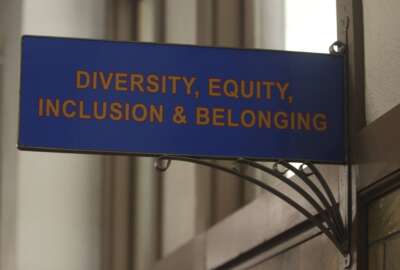After a career in procurement, she’s selling to the government
"We continue to expand on professional services, because our goal is to create as much employment opportunity as we can," said Soraya Correa.
A long-time federal career procurement executive has a new job. She’s the CEO of a contractor. But not just any contractor but a non-profit with a purpose. Soraya Correa was chief procurement officer at the Homeland Security Department, among other things, and retired as a member of the Senior Executive Service. This year she became president and CEO of the National Industries for the Blind. Ms. Correa joined the Federal Drive with Tom Temin.
Interview transcript:
Tom Temin And I would say this is a company with a purpose because you’re a nonprofit. And besides breaking even, you’ve got a really important mission.
Soraya Correa Yes, we do. We’re the National Industries for the Blind. And our primary purpose is the employment of individuals who are blind, visually impaired or low vision. In fact, we, along with our 100 affiliated nonprofit agencies, are the largest employment resource for individuals who are blind or visually impaired.
Tom Temin And this goes back quite a number of years. There’s a long history to this group.
Soraya Correa That’s correct. 86 years, as a matter of fact. 86 plus years. We were founded in 1938 when the Javits Wagner O’Day Act was implemented today, known as the AbilityOne program, basically. And basically it was created so that we could find jobs for individuals who are blind or have significant disabilities. We are one of two central nonprofit agencies. The other nonprofit agencies is Source America. We focus primarily on blind and visually impaired, although we hire people with other disabilities as well and we hired quite a few veterans, as a matter of fact. But we tend to have two primary focus areas and our supports of the ability one commission.
Tom Temin And of course, that makes you a an official federal contractor for just give us a range of the products. I think people are surprised that it’s not just pens and things like that anymore.
Soraya Correa That’s quite correct. We do everything from yes pens, paper, office products, for lack of a better term, janitorial and sanitation products. We build aircraft parts in one of our facilities. We do a whole host of activities and we manufacture products from scratch or we kit products, meaning put products together in packages for sale to the government. We also do uniforms, quite a few uniforms for our military. In fact, the Defense Department is one of our largest customers in that area. The other thing that we do are services. We do contract management services, contract closeouts. We do call center services. We do 508 accessibility services to access. And you’d be surprised how many people don’t really know that business. And we continue to expand on professional services, because our goal is to create as much employment opportunity as we can so people have a choice whether they’re working under the AbilityOne program or they’re working on the commercial side, because we also do commercial work for other vendors.
Tom Temin And the work itself is carried out in the employment by subcontractors, if you will, to the national industries for the blind. Is your job mainly oversight of those operations?
Soraya Correa That’s correct. We call those nonprofit agencies that’s the terminology we use for them. They’re not really subcontractors because they’ll actually have contracts direct with the government. But we oversee their work and we help them. We do compliance checks on them to make sure that they’re complying with all the regulatory requirements of the AbilityOne program, but also we provide services to them. We provide grants, loans. We provide training, we provide engineering support to help them enhance capabilities to create improvements in their business processes or even improvements in their manufacturing lines. So we provide a whole host of services to assist them in getting the job, and then we monitor and make sure that they are meeting the terms and conditions of their contracts or if we need to step in and help them, we will do that as well.
Tom Temin And when you were procurement executive at DHS, you had certain metrics to meet. Are we within budget? Are we delivering to our client agencies through procurement what it is they actually need and not what sometimes they thought they needed or what the contractors interpreted what they needed? Lots of different parameters. What are the chief challenges here? What do you need to keep so that the whole operation is on the rails?
Soraya Correa So here what’s critically important is making sure that our nonprofit agencies can deliver and perform and making sure that the customers properly identify their requirements so that we can get them added to the procurement list. Because the way the process works, there’s a procurement list that’s maintained by the AbilityOne commission. We can add our products and services to that list, certain products and services. We could do it by location, we do it by a multitude of ways so that then the agencies can enter into contracts with us. And what we want to make sure is that those products are properly identified, they are properly captured, and then we oversee and make sure that we select the correct nonprofit agencies or MPAs to provide that support or service or that product to the government customer.
Tom Temin Right. So it’s kind of similar to what you did, which is compliance and final delivery within specs and within budgets.
Soraya Correa And it’s about mission. It is about mission. It’s not just about the mission that we serve of making sure that we are employing individuals who are blind or visually impaired. But it’s also about that government mission. It’s making sure that we are delivering the products and services that are needed by our federal government, our military institutions to make sure that we deliver to those individuals that protect and serve our country every day.
Tom Temin We are speaking with Soraya Correa, president and CEO of the National Industries for the Blind. And you mentioned manufacturing aircraft parts and for that matter, even a pen is about 10 or 12 different individual pieces when you think about it, of different materials. And what are the technological bases for allowing people to do manufacturing that are hearing that are seeing impaired or blind? Because I think of those as highly visual activities.
Soraya Correa Actually, there’s quite a bit of technology. The technology has advanced significantly over the last 15, 20 years and there is much more capability to help people so that we can help them train and better use equipment and technology to build these products. And it is amazing. I am going to tell you, Tom, that I’ve gone out and visited over 15 nonprofit agencies and seen how they do their work. And it is just impressive to watch these individuals doing these, building these products and making uniforms, using sewing machines and other products based on technology where they have either voice instructions being given to them or helping guide them on how to do the work. It is just incredible. And here’s the thing that I guess I find most amazing. These individuals are excited about doing this work. They enjoy the job that they have. They really feel they’re doing something great for their country. And I got to close it by saying, and we’re American companies trying to build American products every day.
Tom Temin In the area of, say, call center support. And that’s a growing area for the government. They’ll never get away from call centers, no matter how much AI is on the website and so on. What is the state of the art with respect to being able to ascertain what is on a complicated screen with lots of windows nowadays? Because that’s what call centers are doing. The call center operator is the one looking at a screen.
Soraya Correa So we have a variety of technologies. And what’s amazing is there is technology, and I’m just going to keep it simple, going to try to get technical with terms. But there is technology that actually helps the user, meaning the individuals who are blind or visually impaired to actually see what’s on the screen or hear what’s on the screen. It actually talks to them and tells them where on the screen is the information that they are looking for. And then it’s interesting because they’ll have a headphone on right. And in one ear they’re hearing the customer and the other ear they’re hearing their computer telling them how to navigate the screen to find the information, the scripts. Because if you know most call centers work off of scripts, it’s individuals with scripts and information conveying information to the user, answering questions. So the capability is actually pretty simple when you think about it to deliver the service in terms of doing it. But to have that technology that actually tells you where to find things on the screen, just amazing. I’ve had a demonstration that I’m going to tell you, they can speed up the computer. And to us, it would sound like garbled messages, to them they’re understanding perfectly what it says.
Tom Temin Yes. I’ve heard the read over the years that the sensors that remain for people lacking a sense are sometimes enhanced by some crazy mechanism of the universe.
Soraya Correa Yes. And the talent, the capability, the skill, the people that we meet. And here’s one of the things that I guess fuels my passion, is I hear the stories and I meet the people who started out in the manufacturing line when they didn’t even think that they could ever have a job because of their disability. But they develop the confidence, the skills, and they have moved on to higher level professions. So recently we had our training conference and I had a panel of female CEOs, because I’m going to highlight female CEOs every time, one of them was blind on that panel. And she was amazing. She tells her career story and she grew up in our industry. She grew up in our business. The final panel of our conference was five blind CEOs telling their story about how they rose to the top to become the CEOs of nonprofit agencies. So the abilities, the capabilities and the training and the support that they receive is endless. And this is why I’m here, is because I just get very excited about knowing that we’re helping our fellow Americans.
Tom Temin Because as a SESer and someone operating at a very visible level at Homeland Security, and we all know what you did there, you could have had your pick of anything. Some people go into consulting and get paid $5,000 a month from 12 different companies to Alpine. Some people go into profit industry. What attracted you to this direction? I guess maybe you just said why.
Soraya Correa It’s the service. And I did the little consulting thing for a couple of years and it just wasn’t me. This is me. This is about having a mission, a purpose, providing a service, and knowing that at the end of the day, I’m doing something that benefits our country and benefits people. I’m fueled by that. That’s what drives me. And if I’m going to do something in my second career, because I already flunked retirement, we figured that one out. So I’m going to do something in my second career. This is what I really want to be doing.
Copyright © 2025 Federal News Network. All rights reserved. This website is not intended for users located within the European Economic Area.
Tom Temin is host of the Federal Drive and has been providing insight on federal technology and management issues for more than 30 years.
Follow @tteminWFED






